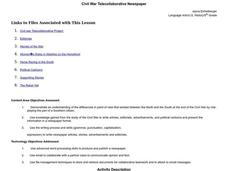Curated OER
Action-Reaction! Rocket
Students construct a rocket from a balloon propelled along a guide string. They use this model to learn about Newton's three laws of motion, examining the effect of different forces on the motion of the rocket. They measure the distance...
Curated OER
Introduction to Archetypes
Here is a full lesson with all the needed materials and PowerPoints attached! Introduce your class to archetypes by showing them the included presentation. The presentation gives definitions and examples of archetypal characters,...
Teach Engineering
Enough Energy? Play the Renew-a-Bead Game
Pairs simulate the energy usage of different countries by drawing beads from a bag, which contain different beginning ratios of non-renewable and renewable energy resources. The activity concludes with a series of questions to tie the...
Teach Engineering
Bridge Types: Tensile and Compressive Forces
Bridges rely on tension and compression to keep them standing. Pairs test this principle by constructing simple bridges and applying a force to the center. Teams use the provided worksheet to record their observations of the reaction of...
Utah Education Network (UEN)
Values
Being self-aware of personal wants, needs, and values is a big part of growing up. Here, you'll find seven different teaching options and two different introductions to a lesson on getting learners to think about their personal values....
Polk County Public Schools
The Blame Game for the Loss at Pearl Harbor
Known as the day that will live in infamy, the attack on Pearl Harbor in 1941 was a shock to all. But why was the United States unprepared on that December morning? Study a series of primary sources in a document-based question that...
Curated OER
My Community Book
Young learners examine different places in their neighborhood using informational texts. First they identify a place that they like to play and predict if it will be in the nonfiction book Community at Play.They will share their favorite...
Teach Engineering
Can You Resist This?
Some things are hard to resist. Small collaborative groups build circuits and calculate the voltage using Ohm's Law. Budding engineers explore the connection between the voltage across different resistors and linear functions with...
Teach Engineering
Energy and the Pogo Stick
Let your class bounce to examine the concept elastic potential energy. Individuals bounce on a pogo stick in order to calculate its elastic potential energy. Groups then compare the elastic potential energy to the gravitational potential...
Curated OER
HISTORICAL AND SOCIAL SCIENCES ANALYSIS
Students examine a variety of maps and documents to identify physical and cultural features of neighborhoods, cities, states, and countries, to explain the historical migration of people, expansion and disintegration of empires, and the...
Curated OER
All About Me
Middle schoolers develop and present a power point presentation. In this getting to know you instructional activity, students create a power point presentaion that describes themselves. Middle schoolers include information about what...
Curated OER
Slavery
Students, in groups, research primary sources and internet sites about different views on slavery. The groups form as either from the point of view of slave owners or those who want to abolish slavery. They write a written argument for...
Curated OER
Frederick Douglas and Abraham Lincoln
Students discuss the significance of the announcement of the Emancipation Proclamation and the assassination of Lincoln. They analyze how historians use evidence and develop differing interpretations. Students examine historical bias and...
Curated OER
Colonial Tea Parties
Students compare protests and points of view from two different accounts of the Boston Tea Party. They then create a flyer inviting other colonist to participate in the dumping of the tea.
Curated OER
Develop Your Own Interpretation
Students use pieces of Andy Warhol's art to write critiques. Using different points of view, they answer discussion questions and share them with the class. They also interpret the art from a historian and artist point of view. They...
Curated OER
Fact and Opinion
In this writing activity, students identify and describe the difference between a fact and an opinion. They place the cut-up words from the house ad in the correct column to indicate if they are fact or opinion.
Curated OER
Media as a Representation of Reality
Students examine different viewpoints and representations of events. They discover that viewpoints are constructed from different points of view. They also examine how they represent real events.
Curated OER
Civil War Telecollaborative Newspaper
Fifth graders analyze the different points of view in the Civil War. They role-play a Southern citizen, write and publish a newspaper article, e-mail a partner, and create a class newspaper with articles, editorials, ads, and political...
Curated OER
Life on the Lewis and Clark Trail
Students examine the lives of Lewis and Clark. Putting themselves in their shoes, they identify the hardships and circumstances faced by them on the trail. Using the internet, they read journal entries from different points of view. ...
Curated OER
Cultures
Students examine and analyze photographs of other cultures. They answer discussion questions, identify bias and point of view in the images, conduct research on another photo, and compare and contrast two cultural images.
Curated OER
One Step At A Time
Students begin the lesson by discussing how two people watching the same event can see it differently. After viewing an overhead transparency, they report on what they saw after being called upon. They discover that what we see is our...
Curated OER
Stakeholder Debate: Ethics and Lead
High schoolers work in teams to develop a presentation and handout representing a particular point of view in a Lead Debate. They synthesize their varied knowledge of lead and its issues, organize this knowledge, and present it...
Curated OER
The "Real" Fairy Tales
Learners write a Fairy Tale from the point of view of the "bad guy".
Curated OER
Summarizing Key Information
Imagine the surprise when small groups present their Evidence Charts to the class and discover that each group has studied a different version of the Cinderella story. Irish, Ojibwa, Egyptian, Chinese, Korean, Persian, Mexican, and...

























